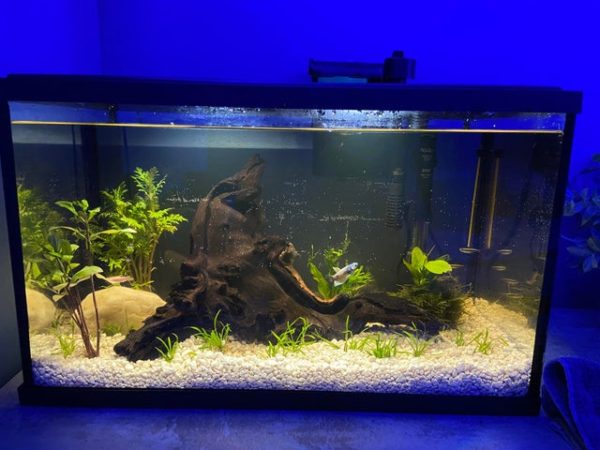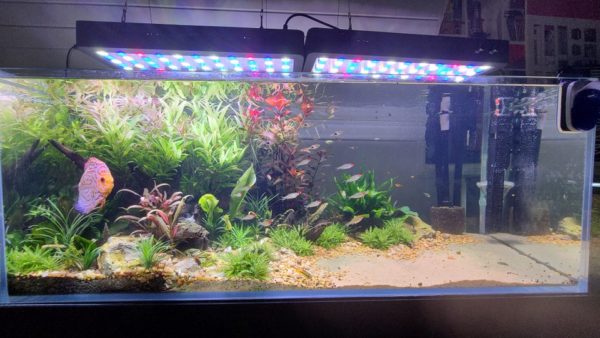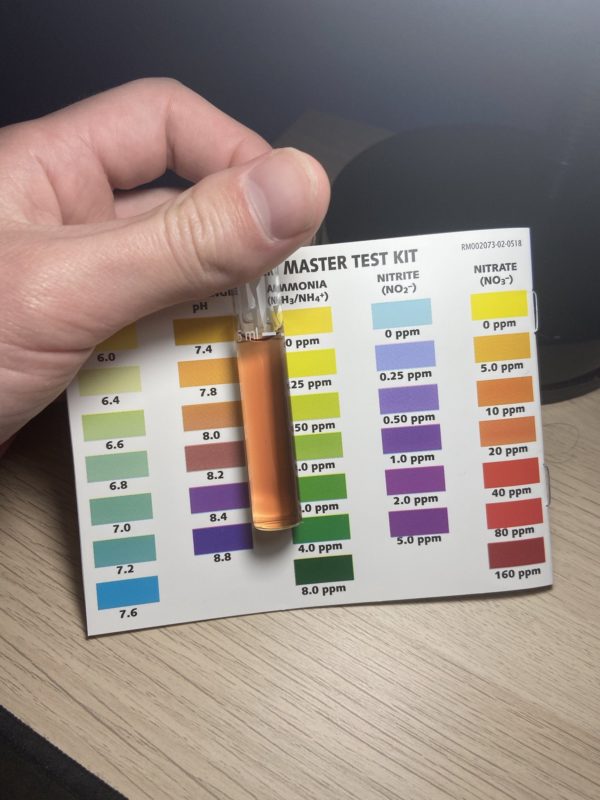You might have heard about cycling a tank from a lot of hobbyists as well as from your local fish store owner. But, what does it mean? And how long does it take?
You might have gotten a new fish, and you were advised to cycle the tank before putting your fish in. But, how long does this take? Did this question ever cross your mind? Well, we have made this guide for you to understand the meaning of cycling your tank. This guide will tell you how long it will take you to cycle your tank. So, read on to know more!
Table of Contents
What is cycling?
Cycling is a time-consuming operation that must be completed whenever you get a new aquarium. The term “cycling” describes the process of building bacterial spores that control the nitrogen cycle in your tank. It also means transforming ammonia into nitrate. There are no other ways to instantaneously create an essential robust nitrogen cycle in a fresh tank.

Which products should I use to cycle an aquarium?
1. Thermometer
Water temperature is a very crucial parameter that you need to check regularly. This is because water temperatures keep fluctuating over time. When you start adding animals, you should monitor the temperature regularly.
You can buy our recommended thermometer No products found.
2. Refractometer
The refractometer is the next most critical device for your tank after the thermometer. It’s just as crucial to maintaining a constant temperature as maintaining a continual sodium content in your tank. Hydrometers can also be used to determine your salt content. However, they are highly imprecise. You must avoid using them if you are serious about maintaining your tank’s salt level.
You can buy our recommended refractometer here!
3. Live Bacteria Culture
To start the cycling process, using a live bacteria culture is always suggested. Most hobbyists start the cycling process by treating their tank as though it contained fish. However, this usually creates a debris issue that may quickly spiral without control. This will put your fresh tank on the wrong track. You could help to accelerate the cycle time. You can also build a very high-quality bacteria colony to proliferate and generate the greatest Bio-filtration for your fresh tank. This can be done by utilizing the proper sort of live bacteria culture.
You can buy one of the most favorite live bacteria cultures here!
4. Ammonia Test Kit
Testing ammonia level is one of the first quantifiable parameters during the cycling process of your tank. Once the Nitrosomonas Bacteria convert ammonia into nitrite, the ammonia level will grow and fall. Monitoring the progress of the cycle will be difficult without testing ammonia levels.
You can buy our recommended ammonia test kit here!
5. Nitrate Test Kit
Testing the nitrate levels in your tank is another quantifiable parameter for when you conduct the cycle. When the levels of ammonia drop, the Nitrite levels will climb. You’re getting close to the conclusion of the cycle when the Nitrites start to plummet, and hence your Nitrates begin to climb gently.
You can buy our recommended nitrate test kit here!
Why is it important?
Cycling is crucial since it encourages the overall growth of beneficial bacteria in the tank. This bacteria functions as a bio-filter for different types of waste that a fish may create. Its feces or excrement contain large quantities of lethal ammonia. This will be turned into nitrites and eventually non-toxic nitrates.
How Do I Cycle MY Fish Tank?
Step 1: Set up your new tank

You must first build your aquarium before starting with the cycling process. Introducing live plants to the new tank would enhance its appearance and accelerate the nitrogen cycle’s acceleration. This is due to the fact that there will always be bacteria present, which will aid in breaking down the ammonia levels.
Step 2: Add your new fish
If you aim to have a giant aquarium with different fish species, you need to hold on before doing so. To start off, only add a new fish to your tank. This will reduce the amount of waste generated. Therefore, there are fewer chances of your tank getting toxic.
Step 3: Limit the fish food
Excessive fish food increases the waste problem in the tank. If left to float around the water, leftover food will be harmful to the fish and the quality of the water. During the cycling process, it is better to limit the fish food supply in your tank in order to reduce the ammonia build-up.
Step 4: Conduct periodic water change
During the cycling process of the tank, you must do a regular water change. You must remove 10 to 25% of the water. You will have to add more saline solution if you own a saltwater tank.
Step 5: Test the water
During the cycling process, you need to keep a check on the ammonia and nitrate levels in your tank. For this, you must invest in a water testing kit. Checking the water with the equipment every few days is always a good practice. Ensure that the levels of ammonia stay below 0.5mg per liter. The level of nitrate must be below 1mg per liter.

If the ammonia and nitrate levels fall to zero, it indicates that the cycling process has been completed. Once this is done, you can go ahead with adding more fish to the tank! Leave a one-week buffer period before you continue adding more fish. This will give the bacteria the time to settle down and adapt to the highest quantity of waste that is being generated.
How long does it take to cycle a tank without fish?
You can cycle the tank using fish food or using pure ammonia. Fish food takes more time to complete the nitrate cycle than using pure ammonia. This is because fish food needs longer to decompose as compared to ammonia. Without the fish, you can take between 4 to 6 weeks to finish the cycling process for the tank.
How long does it take to cycle a tank with the fish?
It can take between 6 to 8 weeks to finish the cycling process of the tank with the fish. In this method, you will essentially use fish waste as an ammonia method. Once you have added the fish to a newly set up tank, you will give the fish some food, and then the fish will excrete waste in the tank. The waste will convert to ammonia only when the breakdown process starts. This will transform ammonia into nitrate. Later, nitrate will convert to nitrate.
Why is my fish tank taking so long to cycle?
There may be several reasons why your tank is taking so long to cycle. Some of them are as follows:
1. High ammonia or nitrate levels
When the ammonia level is beyond 44 PPM, it becomes very toxic for the beneficial bacteria. Hence, checking the ammonia levels is always going to be helpful. A partial water change is recommended if you notice the ammonia level going beyond 44 PPM. This will reduce the levels of ammonia in the water. If the nitrate level is high, it will stall the cycling process. The nitrate level should never be beyond 4 PPM. Partial water change is also recommended if the nitrate levels go beyond 44 PPM, partial water change is also recommended.
2. Low pH level of the water
Another reason why the cycling process takes so long for you could be the low pH levels. Use an API testing kit to check the pH level of the water. If it is below 7, you must do a partial water change or aerate the tank. The pH of the water usually decreases if the tank water has very high levels of CO2. Since CO2 is acidic, it generates carbonic acid in the water. Using an air pump will increase the oxygen levels in the tank. This is the best way to increase the pH level of the water.
How can I speed up cycling my fish tank?
There are several ways to speed up the cycling process. Read on to know more!
1. Dechlorinating the water
Chlorine will be harmful to the fish as well as for the beneficial bacteria present in the tank. It is essential for you to dechlorinate the water before adding the fish to your tank. You can use agents like Saechem Prime to dechlorinate the water.
2. Monitor the pH
You need to ensure that the pH level in the tank stays above 7. This helps the beneficial bacteria to grow in your tank. If the pH goes above 7, then do a partial water change of about 20%.
3. Increase the temperature
Warm waters help the beneficial bacteria to grow in a healthy way. Increasing the temperature will help in speeding up the cycling process. 83 to 87 degrees Fahrenheit is the best for the beneficial bacteria to grow. However, it is essential to note that you can only increase the water temperature if you opt for a fishless cycling process.
4. Increase oxygen levels
Beneficial bacteria thrive on higher oxygen levels. This will help in speeding up the cycling process. Increasing oxygen levels will help the bacteria to flourish in your tank more healthily. An air pump can aid in increasing the oxygen levels of the tank.
5. Do not shut down the filter
During a fishless cycling process, beginners are very prone to shutting down the filter. The filter floss in the tank filtration system is the most excellent spot for helpful bacteria to flourish and create communities. Beneficial bacteria may grow and form their colonies due to the porous nature of the sponge. If you do not turn off the filter, there will be a constant water flow. Beneficial bacteria require regular water to survive!
How do I know when my aquarium has cycled?
If the measurements for ammonia, nitrite, and nitrate in the tank water indicate 0 ammonia, 0 nitrites, as well as some nitrates, it means that the cycling process is done. It usually takes 4 to 6 weeks to cycle a new tank.
How can I cycle my fish tank in 24 hours?
You can do this in the following two ways:
1. Using a filter media of a filter from an established tank
With this method, you would not have to wait for even 24 hours! If you have an established tank, simply take out its filter, remove its sponge, and replace it with a new sponge. Now, attach this filter to your new tank. The filter from the established tank will already have beneficial bacteria in it. This will speed up the cycling process for your new tank.
2. Adding a bottle of live nitrifying bacteria
With this method, you will be adding beneficial bacterial from a bottle into your tank. Hence, your tank will already contain beneficial bacteria, converting the waste materials excreted by the fish into nitrates. One issue with bottled live bacteria is that most of them die once it reaches you. However, this is not always the case.
What about Chemicals to Cycle My Aquarium Faster?
Adding chemicals will not actually help you cycle the aquarium faster. Some components of the chemicals can also be harmful to the fish. Hence, you should stick to the methods mentioned above.
Conclusion
Cycling is essential since it ensures that your fish grows in a healthy environment. If you opt for fishless cycling, you will take between 4 to 8 weeks to finish up the process. You can speed up the process with the help of the methods mentioned above. Waiting for the cycling process to be over can be tiring. However, it creates a healthy environment for your fish to grow. We hope this guide has helped you understand the cycling process in a better way!
No related posts.
